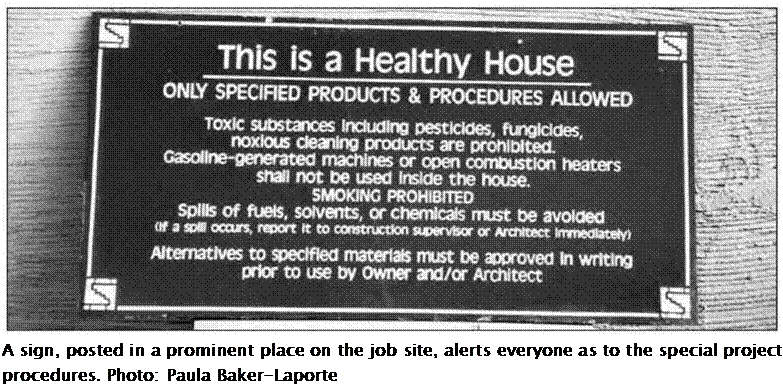A Mishandled Spill
Early in his career as an environmental consultant, John Banta received a frantic call from a woman with chemical sensitivities who was in the process of having a home built. Theclient had painstakingly detailed plans and specifications with the help of John and her architect. The project had proceeded virtually without problems, and was entering the final interior painting and sealing process when a worker for the subcontracting painter accidentally kicked over a bucket of nontoxic paint, spilling it on the unfinished floor. The worker ran to his truck and grabbed a can of mineral spirits, which he used to clean up the spill. The solvent soaked into the floor and the fumes filled the house. John’s client became distraught because her new house was making herfeel sick.
Discussion
In spite of all the best efforts, accidents still happen. The subcontractor failed to educate his worker. The spilled paint was water-based, which meant that the use of mineral spirits was unnecessary and inappropriate. The painter should have wiped upas much as possible using clean rags and then scrubbed the rest with water. Since the floor was unfinished, any remaining paint could have been removed with sanding.
Many attempts were made to remove the noxious mineral spirit odor from the home, but the solvent had been absorbed by the construction materials. Even pulling up the contaminated portion ofthefloor was insufficient to fix the problem. The cleaning substance used by the painter was clearly in violation of the job contract and it appeared that a lawsuit was imminent. Fortunately, the house was quickly sold to a less sensitive person who wanted an ecologically constructed home and who was not affected by the residual odor of mineral spirits.
• The contractor shall verify that all materials are undamaged, uncontaminated, and free of acquired odors prior to installation. Any products found to be defective shall not be used unless approved by the owner or architect.
Even if your contractor is well aware of your intentions, he or she will probably not have the chance to personally speak to every person who will work at your site during the course of construction. It is important that the special rules that apply to your home be posted
 |
in a prominent spot where all who enter will read them. You can specify that a job sign be made and posted. Sample wording that can be placed in your specifications follows:
The following sign is to be made and prominently posted on the jobsite. It is the responsibility of the general contractor to ensure that the labor force, all subcontractors and their labor forces, all suppliers, and all other visitors are made aware of these rules and follow them at all times.
SIGN TO BE POSTED:
This house is being constructed as a healthy home. Only specified products and procedures may be used. If in doubt, contact the general contractor.
The use of any toxic substances such as insecticides, fungicides, or noxious cleaning products is prohibited anywhere on this site.
Smoking within or near the building and its garage or outbuildings is strictly prohibited.
No gasoline-generated machines or open combustion heaters shall be used inside or
near the house after the foundation is completed.
Spills of fuels, solvents, or chemicals must be avoided. If a spill occurs, report it to the general contractor immediately.
Alternatives to specified materials must be approved in writing by the owner and/or architect prior to use.
Because it is difficult to foresee every single product application that will be required in a project, it is prudent to list the major categories of prohibited materials that are the worst health offenders. This gives the general contractor and subcontractors the “big picture” in terms of materials. Sample language containing such a list follows: [3]
• asphalt or products containing asphalt or bitumen
• commercial cleaning products other than those specified
• adhesives, paints, sealers, stains, and other finishes except as specified
• any building materials contaminated by mold or mildew
• any building materials or components that have been contaminated while in storage or during shipment
Contact the architect for further instructions about any application where these substances would normally be used if information for a substitution is not in this document.






Leave a reply